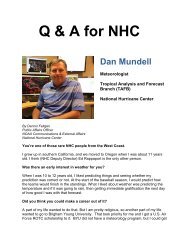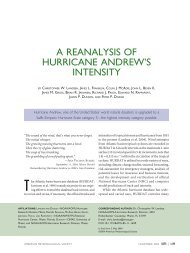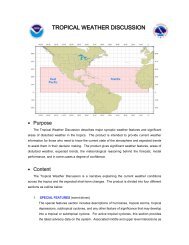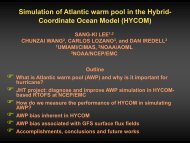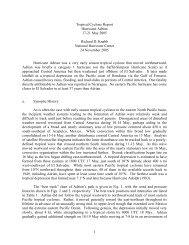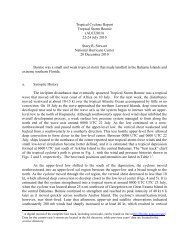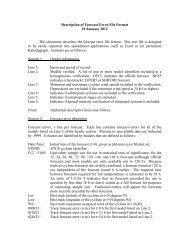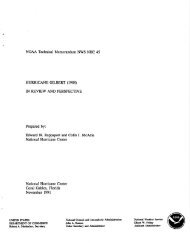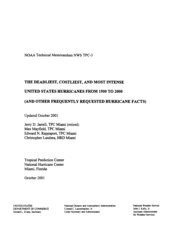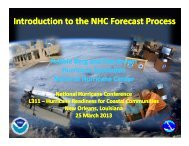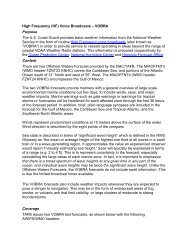High Wind Drag Coefficient and Sea Surface Roughness in Shallow ...
High Wind Drag Coefficient and Sea Surface Roughness in Shallow ...
High Wind Drag Coefficient and Sea Surface Roughness in Shallow ...
Create successful ePaper yourself
Turn your PDF publications into a flip-book with our unique Google optimized e-Paper software.
We would hope to obta<strong>in</strong> > 10 profiles over l<strong>and</strong> to substantiate the differences with onshore<br />
flow over shallow water <strong>and</strong> open ocean flow over deep water <strong>in</strong> the MBL group. However,<br />
sondes are not permitted to be launched over l<strong>and</strong> so it is rare that such profiles are available<br />
(apparently the <strong>in</strong>l<strong>and</strong> sondes shown here were advected <strong>in</strong>l<strong>and</strong> from offshore or from a bay/<br />
sound (e.g. Onslow Bay, Pamlico Sound, Lake Ponchartra<strong>in</strong>).<br />
C. Rema<strong>in</strong><strong>in</strong>g work<br />
1. Open-ocean deep water profiles<br />
The database will be queried to remove the shallow water data from the open ocean profiles to<br />
better contrast the differences between onshore flow over shallow water <strong>and</strong> open ocean flow<br />
over deep water. Data will be QC’s accord<strong>in</strong>g to process<strong>in</strong>g QC flags, number of samples per<br />
b<strong>in</strong>, st<strong>and</strong>ard error of the b<strong>in</strong> mean, <strong>and</strong> outliers.<br />
2. <strong>Shallow</strong> water profiles<br />
The rema<strong>in</strong>der of the shallow water MBL groups will be analyzed to develop mean w<strong>in</strong>d profiles.<br />
Data will be QC’s accord<strong>in</strong>g to process<strong>in</strong>g QC flags, number of samples per b<strong>in</strong>, st<strong>and</strong>ard<br />
error of the b<strong>in</strong> mean, <strong>and</strong> outliers. Based on experience with the 30-39 m/s MBL group, only<br />
the 20-29 <strong>and</strong> 40-49 MBL groups are expected to have sufficient data to construct mean profiles<br />
to determ<strong>in</strong>e surface layer roughness length, friction velocity, <strong>and</strong> drag coefficient.<br />
3. Analysis<br />
Student’s t tests will be conducted to determ<strong>in</strong>e whether the b<strong>in</strong> means of the shallow <strong>and</strong> deep<br />
water profiles come from different populations. <strong>Surface</strong> layer parameters <strong>and</strong> associated error<br />
bars will be computed from least squares fits of the profiles <strong>and</strong> compared as a function of w<strong>in</strong>d<br />
speed for deep <strong>and</strong> shallow water. Analysis of covariance will be used to exam<strong>in</strong>e the slopes <strong>and</strong><br />
<strong>in</strong>tercepts of the mean log w<strong>in</strong>d profiles <strong>and</strong> determ<strong>in</strong>e whether differences exist between the<br />
shallow <strong>and</strong> deep water profiles. Prelim<strong>in</strong>ary results will be presented at the Interdepartmental<br />
Hurricane Conference <strong>in</strong> March 2008.<br />
References:<br />
Powell, M. D., 2007: <strong>Drag</strong> <strong>Coefficient</strong> Distribution <strong>and</strong> <strong>W<strong>in</strong>d</strong> Speed Dependence <strong>in</strong> Tropical Cyclones.<br />
F<strong>in</strong>al report to the JHT, April 2007, 26 pp.<br />
Walsh, E. J., others, M. D. Powell, Black, <strong>and</strong> F. D Marks, Jr., 2002: Hurricane directional<br />
wave spectrum spatial variation at l<strong>and</strong>fall. J. Physical Ocean., 32, 1667-1684.<br />
8




